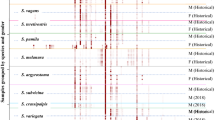Abstract
The cuticular hydrocarbon composition and a stepwise discriminant analysis are used to elucidate the phenotypic relationships of 66 populations of Ixodes ricinus in Europe. The method correctly allocates Ixodes persulcatus (outgroup) populations away from the main cluster of I. ricinus samples and separates the samples into ten relatively defined clusters of specimens. Populations from Poland are inseparable from samples collected in Germany, Switzerland and the Italian Alps, while individuals from Slovakia and the Czech Republic come into separate groups of phenotypic similarity. Irish and British specimens are separated but highly related and Spanish populations show an unexpectedly high distance from the remaining clusters.
Similar content being viewed by others
References
Balashov, Yu. S. 1982. Bloodsucking Ticks (Ixodoidea)—Vectors of Diseases to Man and Animals. Nauka, Leningrad (1968). [English translation in Misc. Publ. Entomol. Soc. Am. 8: 161–376].
Estrada-Peña, A. and Dusbábek, F. 1993. Cuticular hydrocarbon composition of Argas (A.) polonicus, A. (A.) vulgaris, and their hybrids. Exp. Appl. Acarol. 17: 365–376.
Estrada-Peña, A., Estrada-Peña, R. and Peiró, J.M. 1992a. Differentiation of Rhipicephalus ticks (Acarina: Ixodidae) by cuticular hydrocarbon gas chromatography. J. Parasitol. 78: 982–993.
Estrada-Peña, A., Gortázar, C. and Calvete, C. 1992b. Interspecific variation of cuticular hydrocarbons of Rhipicephalus sanguineus, R. pusillus and tentatively determined hybrid specimens (Acarina: Ixodidae). Ann. Parasitol. Hum. Comp. 67: 197–201.
Estrada-Peña, A., Guglielmone, A.A., Mangold, A. and Castellà, J. 1993. Patterns of cuticular hydrocarbon variation and genetic similarity between natural populations of Amblyomma cajennense. Acta Tropica 55: 61–78.
Estrada-Peña, A., Siuda, K. and Castellà, J. 1994. Cuticular hydrocarbon composition and phenotypic variability in sympatric populations of Ixodes ricinus ticks from Poland. Exp. Appl. Acarol. 18: 247–263.
Filippova, N.A. 1990. The taxonomic aspects of the transmission of the causative agent of Lyme disease. Parazirtologiya. 24: 257–267.
Filippova, N.A. 1991. A hypothesis for the palaeogenesis of the distribution of the main vectors for Lyme disease. In Modern acarology, F.Dusbábek and V.Bukbá (eds), Vol. I, pp. 109–118. Academia, Prague.
Gray, J.S. 1991. The development and seasonal activity of the tick Ixodes ricinus, a vector of Lyme borreliosis. Rev. Med. Vet. Entomol. 79: 323–333.
Healy, J.A. 1979. Phosphoglucomutase polymorphism in the tick Ixodes ricinus. Parasitology 78: 7–17.
Hilburn, L. R. and Sattler, P.W. 1988. Are tick populations really less variable and should they be? Heredity 57: 113–117.
Hu, C.M., Leuba-García, S., Aeschlimann, A., Kramer, M.D. and Gern, L. 1994. Comparison of the immunological properties of Borrelia burgdorferi isolates from Ixodes ricinus between three endemic areas in Switzerland. Epidemiol. Infect. 112: 533–542.
Humair, P.F., Péter, O., Wallich, R. and Gern, L. 1995. Strain variation of Lyme disease spirochaetes isolated from Ixodes ricinus ticks and rodents collected in two endemic areas in Switzerland. J. Med. Entomol. 32: 433–438.
Hunt, L.M. 1986. Differentiation between three species of Amblyomma ticks (Acari: Ixodidae) by analysis of cuticular hydrocarbons. Ann. Trop. Med. Parasitol. 80: 245–249.
Keirans, J.E., Oliver, J.H., Jr., and Needham, G.R. 1992. The Ixodes ricinus/persulcatus complex defined. In First International Conference on Tick-borne Pathogens, U.G. Munderloh and T.J. Kurtti (eds). Saint Paul, Minnesota, USA.
Kendall, M., Stuart, A. and Ord, J.K. 1983. Advanced Theory of Statistics, Vol. 3: Design and Analysis of Time Series (4th edn). High Wycombe, UK.
Kolonin, G.V. 1981. World Distribution of Ixodid Ticks (genus Ixodes). Nauka, Moscow.
Kruger, E.L. and Pappas, C.D. 1993. Geographic variation of cuticular hydrocarbons among fourteen populations of Aedes albopictus. J. Med. Entomol. 30: 544–548.
Leuba-Garcia, S.M., Kramer, M.D., Wallich, R. and Gern., L. 1994. Characterization of Borrelia burgdorferi isolated from different organs of Ixodes ricinus ticks collected in nature. Zbl. Bakt. 280: 468–475.
Liebherr, J. K. 1988. Gene flow in ground beetles (Coleoptera: Carabidae) of differing habitat preference and flight wing development. Evolution. 42: 129–137.
Lockey, K.H. 1978a. The adult cuticular hydrocarbons of Tenebrio molitor L. and Tenebrio obscurus F. (Coleoptera: Tenebrionidae). Insect. Biochem. 8: 237–250.
Lockey, K.H. 1980b. Hydrocarbons of adult Tribolium castaneum Hbst. and Tribolium confusum Duv. (Coleoptera: Tenebrionidae). Comp. Biochem. Physiol. 81B: 223–227.
Lockey, K.H. 1988. Lipids of the insect cuticle: origin, composition, and function. Comp. Biochem. Physiol. 89B: 595–645.
McLain, D.K., Wesson, D.M., Oliver, J. H.Jr and Collins, F.H. 1995. Variation in ribosomal DNA internal transcriber spacers 1 among eastern populations of Ixodes scapularis (Acari: Ixodidae). J. Med. Entomol. 32: 353–360.
Phillips, A., Milligan, P.J.M., Broomfield, G. and Molyneux, D.H. 1988. Identification of medically important Diptera by analysis of cuticular hydrocarbons. In Biosystematics of haematophagous insects, M.W.Service (ed.) pp. 39–59. Clarendon Press, Oxford.
Sokal, R.R., Oden, N.L. and Narker, J.S.F. 1987. Spatial structure of Drosophila buzzatii populations: simple and directional spatial autocorrelation. Am. Nat. 129: 122–142.
Zera, A.J. 1981. Genetic structure of two species of waterstriders (Gerridae: Hemiptera) with differing degrees of winglessness. Evolution 35: 218–225.
Author information
Authors and Affiliations
Rights and permissions
About this article
Cite this article
Estrada-Peña, A., Gray, J.S. & Kahl, O. Variability in cuticular hydrocarbons and phenotypic discrimination of Ixodes ricinus populations (Acarina: Ixodidae) from Europe. Exp Appl Acarol 20, 457–466 (1996). https://doi.org/10.1007/BF00053309
Issue Date:
DOI: https://doi.org/10.1007/BF00053309




